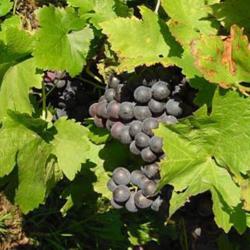
Grapes should be pruned yearly because fruits only form on buds that arise from the previous season's growth. There are various methods of training grapevines. Your preferences, space limitations, and the variety of grape you are growing will determine your trellis system. Prune vines when they are dormant; in most of the country, that means very early spring, before any green shoots appear. Muscadines in the Deep South can be pruned any time after the first fall frost.
FertilizingUnless your soil is very poor, grapes, which are very deeply rooted, don't require much fertilization. Where fertility is low, a soil test will determine whether you should add phosphorus or potassium. For all soils, fertilize lightly the second year. Apply no more than 1/4 pound of 10-10-10 fertilizer in a circle up to 4 feet away from each vine. In following years when the vines are established, apply about a pound up to 8 feet away from the base if growth was slow or foliage color poor the previous season. Apply it only when the buds start to swell in the spring; later fertilizing may cause extensive growth in late summer, making the plant more vulnerable to winter injury.
Grape ChecklistWhile grapevines can survive some neglect, they need regular attention to reach maximum yields:
1) Prune carefully. Leaving too much growth causes far more problems than overpruning.
2) Cultivate shallowly around the base of your plant while it's young to avoid damaging roots near the surface.
3) Fertilize lightly. Unless the soil is particularly poor, grapevines need little feeding. Grape growers encounter a few common problems. For example, if you plant a seedless variety, you may find that your grapes are smaller than those in supermarkets. Grape seeds produce a plant hormone that causes the berries to increase in size. Seedless varieties are missing this hormone and thus produce smaller grapes. If you want larger grapes, keep more buds at pruning and thin out one cluster of every three just before spring bloom. If your grapes are of mature size but fail to ripen on the vine in the (all, the leaves may be shading the grapes, which inhibits ripening. Try pinching foliage-bearing side shoots back to one leaf, which will bring more sunlight and warmth to the clusters.
Grape PestsYour first planting of grapes may escape insect or disease attacks for a while, but eventually some trouble usually arrives. In humid areas, mildew diseases can be a problem; European grapes are very susceptible to downy mildew, for example. Black rot, caused by a fungus, develops in warm, moist climates of Eastern states. Anthracnose, another fungus disease, flourishes in wet spring weather. Japanese beetles, aphids, and mites are common garden insects that you may find. The grape berry moth is a pest in central and eastern regions. Larvae of the moth feed on buds, blossoms, and berries, tying berries together with silken threads as they feed. Two generations usually occur. Clean up grape leaves in the fall to reduce the number of overwintering pests. The following spring, cultivate around plants to turn up overwintered pupae. The grape phylloxera is a pest common in California, where it attacks roots by sucking juices from them and creating galls, and in the East, where it attacks leaves as well as roots. Galls about the size of peas form on leaf undersides. American varieties are resistant, but other types are not. No chemical controls exist; if you have a severe problem, grow American types or European varieties with resistant American rootstocks.
HarvestingGrapes do not ripen off the vine, so pick them when they are completely ripe. Use a sharp knife or small pruner to cut the bunches. Bees and wasps may occasionally light on the grapes to feast on some sweet juice, so watch for them.
 Victory Seed Company has all the seeds you want for your best garden in 2024.
Victory Seed Company has all the seeds you want for your best garden in 2024.
For 25 years, the family-owned Victory Seed Company has provided the highest quality vegetable, herb and flower seeds to families across the country. We are passionate about providing you the best seeds available that give excellent germination, robust plants, and the harvest you want. With a catalog of over a thousand varieties, we have everything, and our prices are the kinds that we'd want to pay. We have hundreds of yesterday's heirloom vegetables, as well as today's award winning hybrid selections. Get to know us by visiting our website and browsing through our online vegetable seed catalog.
| 1. Grape Essentials |
| 2. Planting Grapes |
| 3. Care & Harvesting of Grapes ← you're on this article right now |
| 4. Grape Pruning: Three Systems |
| 5. Buying Grapes |
| 1. Grape Essentials |
| 2. Planting Grapes |
| 3. Care & Harvesting of Grapes ← you're on this article right now |
| 4. Grape Pruning: Three Systems |
| 5. Buying Grapes |